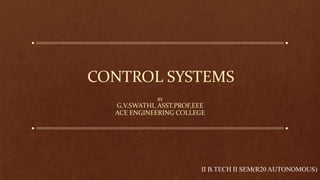This document provides an overview of control systems. It begins with definitions of key terms like controlled variable, controller, plant, disturbance, feedback control, and servo mechanism. It then classifies systems as linear/non-linear, time-variant/invariant, continuous/discrete, dynamic/static, and open-loop/closed-loop. Mathematical modeling approaches like transfer functions and modeling of physical systems like translational, rotational, and electrical analogues are discussed. The document provides a comprehensive introduction to fundamental control system concepts, analysis techniques, and applications.

























![• The denominator is called the characteristic polynomial.
• The transform of the response may be rewritten as
Y(s) = P(s).U(s) + (terms due to all initial values)
• If all the initial conditions are assumed zero then
Y(s) = P(s) U(s)
• And the output as a function of time y(t) is simply
𝐿−1 𝑌 𝑠 = 𝐿−1[P 𝑠 . U 𝑠 ] = y(t)](https://image.slidesharecdn.com/controlsystems-230802150835-5b32de73/85/CONTROL-SYSTEMS-pptx-26-320.jpg)



![Mass
Taking Laplace transform
F(s) = M 𝑠2
X(s)
A mass is denoted by M. If a force f is applied on it and it displays distance x, then
𝑓 = 𝑀
𝑑2𝑥
𝑑𝑡2
If a force f is applied on a mass M and it displays distance x1in the direction of f and
distance x2 in the opposite direction, then
𝑓 = 𝑀
𝑑2𝑥1
𝑑𝑡2 −
𝑑2𝑥2
𝑑𝑡2
Taking Laplace transform
F(s) = M 𝑠2[X1 s − X2 s ]](https://image.slidesharecdn.com/controlsystems-230802150835-5b32de73/85/CONTROL-SYSTEMS-pptx-30-320.jpg)

![Friction
A damper is denoted by B. If a force f is applied on it and it displays distance x, then
f = B
𝑑𝑥
𝑑𝑡
Taking Laplace transform
F(s) = B s X(s)
If a force f is applied on a damper B and it displays distance x1in the direction of f and
distance x2 in the opposite direction, then
f = B[
𝑑𝑥1
𝑑𝑡
-
𝑑𝑥2
𝑑𝑡
]
Taking Laplace transform
F(s) = B s [X1(s) – X2(s)]](https://image.slidesharecdn.com/controlsystems-230802150835-5b32de73/85/CONTROL-SYSTEMS-pptx-32-320.jpg)




























